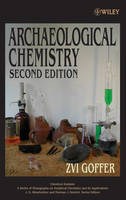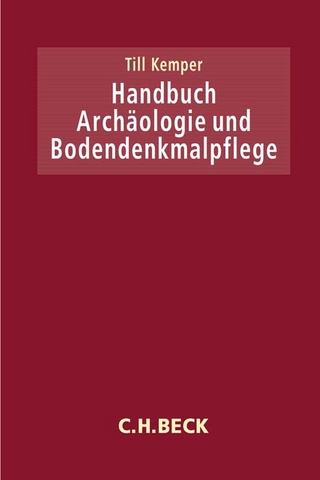
Archaeological Chemistry
Wiley-Interscience (Verlag)
978-0-471-25288-7 (ISBN)
The chemical study of archaeological materials
Archaeological Chemistry, Second Edition is about the application of the chemical sciences to the study of ancient man and his material activities. The text of the book centers on the use of chemical methods, but also refers to the contributions of physics, biology, and genetics to archaeological research.
Subjects discussed in the book include the determination of the nature of ancient materials, their provenance and age, the technologies used for the production of man-made materials, and the analysis of ancient human and animal remains (such as bone, dried blood, and coprolites), which yields information on ancient diets, kinship, habitancy, and migratory patterns.
New developments in analytical chemistry and in related disciplines, which have contributed to archaeological research since the first edition of the book was published, are dealt with in this edition, which also includes:
*
Updated information on the study of the nature, age, and provenance of ancient materials
*
New sections on organic, biological and genetic studies
*
Glossary
*
Extensive bibliography
The book is intended primarily for archaeologists, physical anthropologists and students of archaeology and physical anthropology, but will also be of use to conservators, curators, and art historians. Natural scientists reading it will become acquainted with advances in archaeological research which were made possible only by the application of chemical, physical, and biological methods and techniques.
Zvi Goffer, who received his B.sc. and Ph.D. degrees from the University of London, is a research scientist now retired from the Soreq Nuclear Research Center, Israel. He lectured on Archaeometry at Tel Aviv and Beer Sheba Universities and at the Weizmann Institute of Science in Israel, and was a visiting scientist with the Scientific Archaeology groups at Tokyo National University of Fine Arts, Harvard University, and the Weizmann Institute of Science.
1. Minerals: rock and stone; pigments, abrasives, gemstones. a. The chemical elements.
b. Minerals and mineraloids.
c. Rock and stone.
d. The study of archaeological stone.
e. The chemical analysis of archaeological materials.
f. The provenance of archaeological materials.
g. The chronology of archaeological materials.
h. Pigments.
i. Abrasives.
j. Gemstones.
i. Cutting and polishing gemstones.
2. Lithics: Flint and obsidian.
a. Quartz and flint.
b. Obsidian.
c. Use wear analysis.
3. Sand: glass, glaze, enamel.
a. Glass, glaze and enamel.
b. Glass.
c. Glassmaking.
d. Ancient glass studies.
e. The decay of glass.
4. Secondary rocks: building stone, brick, cement, mortar.
a. Building stone.
b. Cement.
c. The study of ancient cements.
5. Ores: metals and alloys.
a. Native metals.
b. Metalliferous ores.
c. Mining.
d. Ore dressing.
e. Smelting.
f. Metal refining.
g. Alloys.
h. The metals and alloys of antiquity.
i. The deterioration of metals and alloys - Corrosion.
j. The study of archaeological metals and alloys.
6. Sediments and soils.
a. Sediments, oxygen isotopes and ancient temperatures.
b. Soil.
7. Clay: Pottery and other ceramic materials.
a. Primary clay.
b. Secondary clay.
c. Clay and ceramic materials.
d. Ceramic materials.
e. Making ceramics.
f. Common ceramic materials .
g. The study of ancient pottery.
8. The biosphere: Organic and biological substances.
a. Living organisms and cells.
b. Biological matter: organic and bioinorganic substances.
c. Ancient biological materials.
d. Dating organic materials.
9. Carbohydrates: wood, gums, resins.
a. Wood.
b. Gums.
c. Resins.
d. Carbohydrates, isotopes and the study of ancient diets.
10. Lipids: oils, fats and waxes.
a. Oils.
b. Fats.
c. Waxes.
d. Soap.
e. Ancient lipids.
11. Proteins: skin and hide, leather, glue.
a. Animal skin.
b. Skin and hide.
c. Leather.
d. Glue.
e. Dating ancient proteins - amino acid racemization dating.
12. The nucleic acids: Human traits; genetics and evolution.
a. DNA after death.
b. The polymerase chain reaction (PCR).
c. Ancient DNA studies.
13. Fibers: yarn, textiles and cordage; writing materials.
a. Fibers.
b. Textile and cordage fibers.
c. Vegetable fibers.
d. Animal fibers.
e. Inorganic fibers.
f. The study of archaeological fibers.
g. Writing materials.
14. Dyes and dyeing.
a. Stains and staining.
b. The dyeing process.
c. Mordants.
d. The nature of dyes.
e. Ancient dyes.
f. The identification and characterization of ancient dyes and mordants.
15. Bioinorganic materials; bone, ivory, shell, phytoliths.
a. Bone.
b. Teeth.
c. Ivory.
d. Horn.
e. Antler.
f. Shell.
g. Archaeological bone.
h. Bone, stable isotopes and ancient diets.
16. Some ancient remains: mummies, fossils, coprolites.
a. Mummies and mummification.
b. Embalming.
c. Fossils and fossilization.
d. Animal excretions, coprolites.
17. The environment and the decay of archaeological materials.
a. Air and the atmosphere.
b. The composition of the atmosphere.
c. Water and the hydrosphere.
d. Pollution.
e. Air pollutants.
f. Water pollutants.
g. The interaction of materials with the environment.
h. Temperature effects.
i. Sunlight.
j. Oxygen and ozone.
k. Water.
l. Air pollutants.
m. The deterioration of some archaeological materials.
18. The authentication of antiquities.
a. Technical and scientific and methods of authentication.
b. Some authentication studies.
Appendix I. The Chemical Elements.
Appendix II. Chronometric Dating Methods: Selection criteria.
Appendix III. Symbols, constants, units and equivalencies.
Glossary.
Bibliography.
| Erscheint lt. Verlag | 15.1.2008 |
|---|---|
| Reihe/Serie | Chemical Analysis: A Series of Monographs on Analytical Chemistry and Its Applications |
| Mitarbeit |
Herausgeber (Serie): James D. Winefordner, Norman J. Dovichi |
| Zusatzinfo | Charts: 9 B&W, 0 Color; Photos: 30 B&W, 0 Color; Drawings: 34 B&W, 0 Color; Tables: 101 B&W, 0 Color; Graphs: 15 B&W, 0 Color |
| Sprache | englisch |
| Maße | 164 x 237 mm |
| Gewicht | 1043 g |
| Themenwelt | Geisteswissenschaften ► Archäologie |
| Technik ► Umwelttechnik / Biotechnologie | |
| ISBN-10 | 0-471-25288-3 / 0471252883 |
| ISBN-13 | 978-0-471-25288-7 / 9780471252887 |
| Zustand | Neuware |
| Haben Sie eine Frage zum Produkt? |
aus dem Bereich


